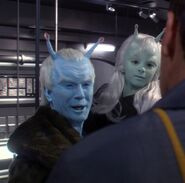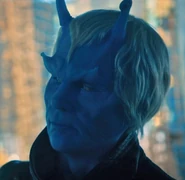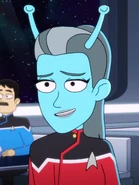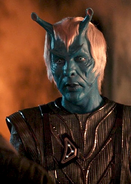"That's them."
The Andorians were a warp-capable humanoid species from the moon Andoria, capital of the Andorian Empire, in the Alpha Quadrant. In 2161, their homeworld became a founding member of the United Federation of Planets.
Quick Answers

What was the capital of the Andorian Empire?

What was unique about the Aenar subspecies of Andorians?

What year did Andoria become a founding member of the United Federation of Planets?

What physical characteristics distinguished Andorians?

What were the hybrids between Andorians and Aenar like?

Biology[]
Andorians had blue skin and white to gray hair. Some individuals had fleshy protruding structures above their eyes instead of eyebrows. The Aenar subspecies had white skin and, unlike mainstream Andorians, were blind and telepathic. Hybrids between Andorians and Aenar had pale greenish skin and were not blind. (Star Trek: The Motion Picture; ENT: "United", "These Are the Voyages..."; DIS: "Despite Yourself"; LD: "Second Contact")
Andorians had a higher metabolic rate than Humans, which could theoretically permit a Human opponent to best an Andorian in hand-to-hand combat by simply exhausting them. This also made them especially vulnerable to phase-pulse infection; even minor phase-pistol injuries could prove fatal. (ENT: "United") However, they demonstrated resistance to a wide range of environmental conditions. In a climate where the temperature was near the boiling point of water, an Andorian could still thrive, despite losing ten percent of their body weight in two days. (ENT: "The Aenar")
Since Andorian physiology made intravenous injection impossible, physicians administered medication through intramuscular injection instead. (TOS: "Whom Gods Destroy")
Andorians could require a tonsillectomy. (DIS: "Choose Your Pain")
The Star Fleet Medical Reference Manual illustrated and called attention to the species' "limited exoskeleton."
Antennae[]
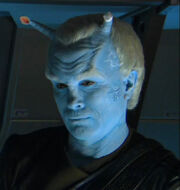
Shran with a missing antenna after his Ushaan against Captain Archer
One of the most distinctive traits of Andorians and Aenar was a pair of antennae on top of their heads. The antennae were moved by voluntary muscles and could be controlled separate from one another. (ENT: "United")
Although an antenna cut off or otherwise separated would eventually grow back, it could be humiliating to lose one or both antennae. (ENT: "United") Though it was typically a temporary loss, it was possible to sever them in a permanent fashion, as happened to Ryn. (DIS: "Scavengers")
Blood[]

The blood and guts of an Andorian female
Andorians were true blue-bloods: Talas' blood displayed non-viscous, translucent qualities, and was as dark blue as Shran's abrasions. Andorian tongues and gums alternated from dark blue to pink. (ENT: "United")
Andorians had increased perfusion in colder environments. On breathing the freezing air of Andoria, Shran remarked how it "really gets the blood running!" (ENT: "The Aenar")
History[]
- Main articles: Andorian history and Federation history
The Andorians originated from the icy moon of Andoria. Early in their history, the Aenar diverged from them as a subspecies, having retreated to the Northern Wastes, thenceforth considered a myth until the early 22nd century. (ENT: "The Aenar")
The Andorians employed ice-cutters to navigate their homeworld; the first to circumnavigate the moon was called Kumari, a name that was carried on to future Andorian vessels. (ENT: "United")
Mirror universe[]
In the mirror universe, Andorians were among multiple races conquered by the Terran Empire by 2155.
While some Andorians served aboard Starfleet vessels like the ISS Avenger that year, other Andorians took part in a rebellion against the Terran Empire. In one engagement, at least two Andorian battle cruisers were present. (ENT: "In a Mirror, Darkly, Part II")
Andorian rebels continued to resist the Empire well into the 23rd century. (DIS: "Despite Yourself", "The Wolf Inside")
Society[]
- See also: Andorian Empire

Symbol of the Andorian Empire in the 2150s
Andorians were a militaristic race, exemplified in small part by weaponry without stun settings. They considered it an honor to serve in their Imperial Guard, and military rank greatly influenced social reputation. Deploring dishonesty – and never fighting without reason – Andorians were nonetheless capable of duplicity. The Andorians were suspicious and volatile. They considered themselves deeply emotional, passionate, even violent; not known for their charity or sympathy, they placed a high value on family. (ENT: "The Andorian Incident", "Cease Fire", "Babel One", "United"; TOS: "Journey to Babel"; TAS: "Yesteryear")
A chirurgeon was a type of medical practitioner on Andoria. (DS9: "Prophet Motive")
Culture and tradition[]
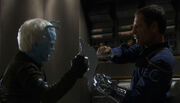
Shran and Archer fight the Ushaan
A crucial part of Andorian tradition was the Ushaan, a code of honor demanding a duel to the death, with combatants pitted against one another using an ushaan-tor ice miner's tool. A vast body of regulations – up to twelve thousand amendments – bound this code. Such a fight could be called off if one combatant disabled the other enough to prevent its continuance. Though Ushaan could be called by someone to avenge a personal loss, there existed a right of substitution wherein each combatant could offer up a replacement, and married combatants could postpone duels indefinitely if they had no children to continue their clans. (ENT: "United")
Members of the Andorian Imperial Guard who died far from home could count on their companions to transport a part of them, for example some of their blood, back to the Andorian ices. As a special honor, the blood of a dead person could be taken to the Wall of Heroes on Andoria. (ENT: "United")

Example of Andorian script
Females enjoyed an equal position in Andorian society, and as soldiers, were as capable as males. Also, they could initiate an intimate relationship by assaulting a male. Andorian weddings required groups of four people, except under certain circumstances. (ENT: "Cease Fire", "Proving Ground", "Babel One"; TNG: "Data's Day")
While it was not specifically stated, this might be an indication of polygamy.
Andorians were well known for their determination and endurance in physical combat. On Andoria, they were taught how to fight with an ushaan-tor when they were children. (VOY: "One Small Step"; ENT: "United")
Andorians made prodigious artists; Ezri Dax's mother, Yanas Tigan, bought hand-painted Andorian tiles for her solarium in 2375, and the Andorian Academy was widely considered the best art school in the Federation. (DS9: "Prodigal Daughter")
Like most species, Andorian society also harbored the idea of Heaven, a dream of a place from which creation sprang. According to Sybok, the word for it in the Andorian language was "unpronounceable." (Star Trek V: The Final Frontier)
Cultural products[]
Food and beverages[]
- Andorian ale
- Andorian fast food
- Andorian tuber root
- Andorian redbat
- Andorian boiler
- Andorian cabbage soup
People[]
Appendices[]
Appearances[]
| Warning! This section may contain spoilers for Star Trek: Discovery. |
- TOS:
- "Journey to Babel" (Season Two)
- "The Gamesters of Triskelion"
- "Whom Gods Destroy" (Season Three)
- "The Lights of Zetar"
- TAS:
- "Yesteryear" (Season One)
- "The Time Trap"
- TOS films:
- TNG:
- "The Offspring" (hologram only) (Season Three)
- "Captain's Holiday"
- ENT:
- "The Andorian Incident" (Season One)
- "Shadows of P'Jem"
- "Cease Fire" (Season Two)
- "Proving Ground" (Season Three)
- "Zero Hour"
- "Kir'Shara" (Season Four)
- "Babel One"
- "United"
- "The Aenar"
- "In a Mirror, Darkly"
- "In a Mirror, Darkly, Part II"
- "Demons"
- "Terra Prime"
- "These Are the Voyages..." (hologram only)
- DIS:
- "Despite Yourself" (Season One)
- "The Wolf Inside"
- "The War Without, The War Within"
- "Will You Take My Hand?"
- "If Memory Serves" (hologram only) (Season Two)
- "Project Daedalus"
- "That Hope Is You, Part 1" (Season Three)
- "People of Earth"
- "Scavengers"
- "The Sanctuary"
- "There Is A Tide..."
- "...But to Connect" (Season Four)
- "All In"
- "Rosetta"
- "Labyrinths" (Season Five)
- PIC:
- "Remembrance" (Season One)
- "Maps and Legends"
- "The Star Gazer" (Season Two)
- LD:
- "Second Contact" (Season One)
- "Envoys"
- "Moist Vessel"
- "Cupid's Errant Arrow"
- "Terminal Provocations"
- "Much Ado About Boimler"
- "Veritas"
- "No Small Parts" (voice only)
- "Strange Energies" (Season Two)
- "We'll Always Have Tom Paris"
- "Mugato, Gumato"
- "An Embarrassment Of Dooplers"
- "The Spy Humongous"
- "Where Pleasant Fountains Lie"
- "I, Excretus"
- "wej Duj"
- "First First Contact"
- "Grounded" (Season Three)
- "The Least Dangerous Game"
- "Mining The Mind's Mines" (fantasy only)
- "Room for Growth"
- "Reflections"
- "Hear All, Trust Nothing"
- "A Mathematically Perfect Redemption"
- "Trusted Sources"
- "The Stars At Night"
- "Twovix"
- "I Have No Bones Yet I Must Flee"
- "Empathological Fallacies"
- "Caves"
- "The Inner Fight"
- "Old Friends, New Planets"
- PRO:
- "A Moral Star, Part 2" (Season One)
- "Asylum"
- "All the World's a Stage"
- "Crossroads"
- "Masquerade"
- "Preludes"
- "Mindwalk"
- "Supernova, Part 1"
- "Supernova, Part 2"
- SNW:
- "Spock Amok" (Season One)
- "Those Old Scientists" (Season Two)
- "Under the Cloak of War"
Background information[]
Originating the species[]
Since Andorians first appeared in "Journey to Babel", their look has changed considerably, both for budgetary reasons and due to improvements in makeup technique. The script of "Journey to Babel" described Andorians, stating, "They are humanoids, tall and quite slim. If at all possible, the ears will be played down (taped back?), but there are two delicately tapered antennae curling from the head. Despite their almost fragile bodies, Andorians are a fierce warrior breed. Their dress indicates this to some extent, and will include a vicious looking bladed weapon... which is carried for use and not ceremony. Andorians are pale blue." [1] The script also stated, "Habitually, because of the sensitive antennae, Andorians listen with heads down and slightly tilted. Andorian voices are also different... soft, whispering."
The Andorians were designed by Fred Phillips. Given virtually no notice that he would be required to design their make-up, Phillips had to do so overnight. (Cinefantastique, Vol. 17, No. 2, p. 32) His original design typically had antennae at the back of his head to cover where they were connected to his white wig. [2] Phillips sculpted the antennae using modeling clay, and according to Star Trek archivist Richard Arnold, Phillips used the ends of thread spools for the ends of the antennae, The main stems were made of a rigid material and attached to the white wigs. The makeup chosen to color Andorians was Max Factor Aqua Blue cream stick, highlighted with a slightly deeper blue cream liner to shadow the face. (Star Trek: Aliens & Artifacts, p. 49)
"I was told the makeup would take a little time," remembered Thelev actor William O'Connell, "and they put on, like, a matte finish for an actor, and then the hair, the antennae, and so on and so forth. It took, I think, almost two hours, so it was laborious." [3] Due to the amount of makeup time required, Andorians were also very costly to do. (The World of Star Trek, 1994 UK ed., p. 182)
The Andorians were kept conceptually vague in Star Trek: The Original Series. Fred Dekker observed, "As far as I know, on the original series it was an interesting makeup concept and there was barely any back story to the characters at all." (Star Trek: The Official Starships Collection, issue 37, p. 11)
The script of TAS: "Yesteryear" described the species thus; "Andorians are slim, almost fragile-looking humanoids with pale blue skin and silver hair. Two slightly curved antennas which end in little flared knobs adorn their heads. These are their listening organs; therefore, no ears are in evidence. When an Andorian listens to anyone speak, he bows his head slightly to get maximum 'receiving'. Andorian speech is accented, softly spoken and deliberate. By heritage, Andorians are a savage race of warriors, and their agility and strength belie their slender builds."
Despite this description, when the Andorian Thelin appeared in the finished episode, he was depicted with gray skin. This was probably due to director Hal Sutherland's color blindness.
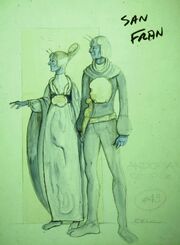
A concept sketch of an Andorian couple for The Motion Picture

An Andorian make-up test for The Motion Picture
In either the original Star Trek series or Star Trek: The Motion Picture, makeup artist Fred Phillips – who worked on both productions – tested Andorian antennae and blue facial makeup on his daughter, Janna Phillips. (The Making of Star Trek: The Motion Picture, p. 140)
The first significant change in the Andorians' appearance came in The Motion Picture, for which Fred Phillips gave the Andorians forehead ridges with thin, spindly antennae coming off the top of the forehead. Both male and female variants of the Andorian appearance were created. (The Art of Star Trek, p. 178) The white wigs for the Andorian females in The Motion Picture were extremely difficult to design. They involved much backing with starchy material as well as wire, and were covered with cotton, together with real hair. (The Making of Star Trek: The Motion Picture, p. 142) In notes that Costume Designer Robert Fletcher wrote about the aliens in The Motion Picture, the description of the Andorians incorporated some elements of their conceptual design that had previously been invented, while also introducing some new facets, and the statement additionally included some costume notes. After pointing out the Andorians were "from tv series", the brief continued as follows:
"Blue-skinned, with white hair and small-knobbed antennae (sensors) out of forehead. Can communicate over great distances. Very musical people, fairly combative. By heritage, a race of savage warriors, with strength masked by soft voices and slender builds. Ladies' costume: hand-painted; adorn sleeves with pieces from planet, used sliced geode framed in brass for ornaments and in hair. Men's costume: has belt and carries Flabbjellah, a combination musical instrument and weapon, carried by most males. Costume of old suede which was stored at Paramount since The Ten Commandments." (The Making of Star Trek: The Motion Picture, p. 133)
An Andorian was storyboarded to be featured among the crew of the Merchantman in Star Trek III: The Search for Spock, though no Andorians appear in that film. (storyboard sequence "The Klingons Attack", Star Trek III: The Search for Spock (Special Edition) DVD special features)
In Star Trek IV: The Voyage Home, makeup evolution allowed an Andorian to be seen as balding, with antennae bases joined seamlessly to the actor's skin.
At the advent of Star Trek: The Next Generation, the Andorians were affected by the fact Gene Roddenberry was insistent on TNG excluding any species featured on TOS, as he wanted the new series to not be reliant on the past. (Star Trek: The Official Starships Collection, issue 37, p. 10) Nevertheless, they were mentioned in an internal reference document, listing all the aliens seen in Star Trek: The Next Generation, which was circulated around the time of the production of TNG Season 5, where they were inexplicably called "Androgens" and described as "blue-skinned, antenna-topped race".
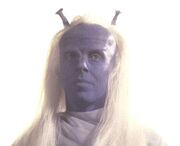
Make-up test for an Andorian god
An Andorian god in Star Trek V: The Final Frontier made it into makeup screen tests. (Star Trek V: The Final Frontier (Special Edition)) This Andorian retained, in the words of Makeup Effects Artist Kenny Myers, "the classic blue look and long, bone white hair" of previous Andorians, as well as the common two antennae, which Myers referred to (in the case of the Andorian Supreme Being) as "little horns." The fact that Andorians were not meant to have ears came as a surprise to Myers. Without knowing whether this was true of the species or not but having been told it was, Myers "played it safe" by covering the ears of the Andorian-playing actor under the wig. (The Making of the Trek Films, UK 3rd ed., p. 90) Like many ideas for the film, the Andorian Supreme Being didn't survive the movie's final cut.
TNG Season 3 offered up two Andorians – one of which was an appearance for Lal – with skin more greenish-blue, larger bulbous heads, and taller spindly antennae attached to the wig. The look of the Andorian Risa tourist was designed by Michael Westmore who used electronics from a novelty potted plant toy which was built to respond to sounds so the plant danced to music, voices or noise. But the idea to make the antennae twist in response to sounds did not work on camera. ("The Andorian Incident", text commentary, ENT Season 1 DVD special feature)
Although "Andorian fast food" was listed in Star Trek: Deep Space Nine set dressing for a Promenade directory, there was no support, in DS9's writing staff, for the idea of an Andorian or multiple members of the species appearing on that series. (Star Trek: Deep Space Nine Companion, p. 13; (AOL chat, 1997)) Writing staffer Ronald D. Moore even doubted that the Andorians would get increased exposure on DS9 and warned viewers not to look for them. (AOL chat, 1997) (AOL chat, 1998)
No Andorian appeared during the run of Star Trek: Voyager and the species itself was only mentioned in one episode, "One Small Step", with an additional mention of Andorian amoeba in "Tuvix".
Over the years since the start of TNG, Andorians had been shown in a few cameos but had stayed relentlessly absent. One reason the Andorians didn't make any substantial return was that their makeup, with their antennae and blue skin, might inadvertently look silly. They actually appeared much less often than Andorian ale. (Star Trek: The Official Starships Collection, issue 37, p. 10)
Prequel appearances[]
Enterprise[]
The decision to feature Andorians in Star Trek: Enterprise was made immediately after Executive Producers Rick Berman and Brannon Braga were considering which villain to incorporate in the story that ultimately became "The Andorian Incident". "We just came up with the Andorians," said Braga. "My feeling on it was: let's take the silliest looking race and make them look cool [....] I wanted to take a fan favorite, and revamp them." (Star Trek: Communicator issue 136, p. 37) Braga also wanted to "make them" become a believable culture. (Star Trek: Communicator issue 139, p. 24) In devising the story for "The Andorian Incident", Braga decided the Andorians would make an ideal adversary to the Vulcans. His confidence that the creative team could give the Andorians a "cool" appearance was due to makeup technology having greatly advanced. (Star Trek: The Official Starships Collection, issue 37, pp. 10-11) However, Braga was at first uncertain if he could convince Rick Berman into okaying the return of the species. "The Andorians were ludicrous!" exclaimed Braga. "I never thought in a million years that I would get Rick to agree to have them on the show, because of the way they looked." (Star Trek: The Magazine Volume 2, Issue 9, p. 20)
Once it was decided to bring back the Andorians, they were the subject of much debate among the members of ENT's creative personnel. "There was a lot of discussion," remembered Michael Sussman, "about how to do them, how to bring their makeup up to date." ("Shadows of P'Jem" audio commentary, ENT Season 1 Blu-ray special features)
The ENT writing staff, in general, were excited about bringing the Andorians back to the screen. Those members of the creative staff who were enthused about the species returning included Fred Dekker, who was given the task of writing "The Andorian Incident" and was entirely unfamiliar with Star Trek fan fiction, so felt he was basically starting from scratch. "The Andorians felt like an untapped mine," he noted. (Star Trek: The Official Starships Collection, issue 37, p. 11)
Updating the highly memorable Andorians proved to be a challenge. This process included giving them more conceptual depth. The story that Berman and Braga concocted for "The Andorian Incident" was thus partly written in an attempt to "get into Andorian psychology a little more, and find out they are highly paranoid." (Star Trek: Communicator issue 136, p. 37) The process of working out their psychology for ENT began by contrasting them with the Vulcans. Stated Fred Dekker, "We wanted the Andorians to be extremely agitated and full of energy [....] What we wanted was the contrast so we made them the opposite of unemotional. They would have a hair-trigger." (Star Trek: The Official Starships Collection, issue 37, p. 11)
In the first draft script of "The Andorian Incident" (which had the working title "Incident at P'Jem"), Andorians were said to be evolved from "subterranean creatures." As a result, their antennae could sense odors and vibrations, helping the Andorians navigate in low light conditions.
In the final draft script for "The Andorian Incident", the Andorians were initially described with the statement, "Flush to their skulls are strange, bony antennae." They were also referred to as having blue skin and white hair, though there were no lengthy descriptive passages detailing how they looked. However, a later description in the same teleplay read, "As we'll see, the Andorians are paranoid and easily agitated."
Although Shran actor Jeffrey Combs was at first uncertain about whether he wanted to accept an invitation to appear on Enterprise, suspicions that the Andorians would likely feature in the same episode sparked his interest, initiated by him learning that the episode was called "The Andorian Incident". "And once I heard about that, that intrigued me a lot," he related, "because I knew that the Andorians had never really been fully explored but were somewhat devious, their makeup would probably be really cool now, ... and that they were founding members of the Federation." Combs also characterized the episode as "kind of a pivotal launching of this species." (Star Trek: Communicator issue 136, pp. 38 & 69)
The Andorians in Star Trek: Enterprise were painted differently than the ones in the past. "We applied the blue in subtle layers to give the skin a translucence instead of just slathering on blue paint," explained Brannon Braga. (Star Trek: Communicator issue 136, p. 37)
Makeup Supervisor Michael Westmore was instrumental in redesigning the Andorians for ENT. He came up with the concept of making their antennae movable. ("Shadows of P'Jem" audio commentary, ENT Season 1 Blu-ray special features) Those appendages were also attached to the forehead and reverted to the thicker, segmented look of the original series aliens. Jeffrey Combs was of the opinion that having the antennae be shown via mechanics was very brave. "They didn't have to do that," he said, "they could have brought the Andorians with just a static antennae." (Star Trek: Communicator issue 136, p. 69)
At first, there were some worries that the servo mechanics used for the Andorian antennae might malfunction or hold up production, concerns felt by delay-conscious producers as well as actors who were each conscious that their individual pair of mechanical antennae – essentially a wayward item of hardware – could end up destroying their scene. "That was my biggest concern – [that] these antennae would overpower, or be too much, and then they're just silly," remarked Jeffrey Combs. "So we minimized these things – we let them do their thing, but let them be like kelp in the sea: they're always there, always undulating, and then every once in a while they react. So it's a really delicate balance, which I think we hit." (Star Trek: Communicator issue 136, pp. 39 & 40)
The antennae went on to be used as tools of subtext that had the potential to add to the performances delivered by the actors. Jeffrey Combs recalled, "I took the tack that they were antennae that depicted deception or perhaps danger – almost like a sixth sense, being able to tell if someone is not being forthcoming. The puppeteer, me, [Director] Roxann [Dawson] – and each of the Andorians had their own puppeteer – ... we quickly realized there were some basic things they would convey: when anger came up, they were like a cat's ears, they would just flare back. And when you were curious about something they would come forward [....] We were trying to find another position for the antennae to show gratitude. We came up with a little heart-shaped position where the tops come in and touch each other – like the Ferengi (subservient hand gesture), only on your heads! So it wasn't technical or antiseptic, it was just how do we make the technical emotional and give it life." (Star Trek: Communicator issue 136, p. 40)
The particulars of the Andorian prosthetics created for ENT had an impact on how the aliens could be used in stunts. "When we're doing physical stuff with the actors that have the antennae that move, we have to be very careful," explained Stunt Coordinator Vince Deadrick, Jr.. "If we snap one of those, it requires a big reset and a huge expense. It's a big makeup deal, and they've got to take everything apart and it's a lot of work. So it's 'No pressure, Vince, but don't break them when you fight!'" (Star Trek: Communicator issue 138, p. 43) The two stunt Andorians seen in "The Andorian Incident" were not equipped with these moveable antennae – tiny electronic servos built into the antennae and radio-controlled by puppeteers in response to sounds and emotions. ("The Andorian Incident", text commentary, ENT Season 1 DVD special feature)
Ultimately, the physical design of the ENT Andorians was highly popular with the writing staff. Mike Sussman regarded the moving Andorian antennae as "great" and remarked about Michael Westmore's work on the species, "I thought he did a brilliant job reinventing the look of those aliens and freshening them up." ("Shadows of P'Jem" audio commentary, ENT Season 1 Blu-ray special features) Brannon Braga was likewise highly pleased with how the species turned out. "They're still Andorians," he commented, "but we gave them better costumes, we made the makeup cooler [....] They look really cool." (Star Trek: The Magazine Volume 2, Issue 9, p. 20) He additionally enthused, "They look just like Andorians, but somehow they just look more believable [....] And their costumes are cool [....] I have to imagine that even (viewers) who haven't yet met the Andorians will really like these guys." (Star Trek: Communicator issue 136, p. 37)
As a result of the redesigned Andorians being thought of as successful, it wasn't long before they reappeared on ENT. "So we went ahead and took a gamble and brought them back fairly soon," commented Brannon Braga. (Star Trek: Communicator issue 136, p. 37) The species was referenced in a working title used by the next episode to feature Andorians, "Shadows of P'Jem", as it was originally called "Untitled Andorians Return". In a line of dialogue from the first draft script for that installment, Andorians were referred to as "a violent, predatory species." However, that line was ultimately changed to Andorian commandos being described as "a dangerous group." The only general physical description of the Andorians in the episode's final draft script – in that case, referring to the Andorian blue complexion and antennae – was specifically in reference to Shran alone.
Following "Shadows of P'Jem", depicting the Andorians again was certainly of interest to the ENT writing staff. "We were very eager to bring back the Andorians," Brannon Braga recalled, at the conclusion of the second season. "We were just waiting for the right story idea to come along [....] It's still amazing that you can take blue guys with antennae and make them believable. They're turning into a very interesting species." (Star Trek: Communicator issue 145, p. 28) The two aforementioned physical attributes had become so clearly the defining characteristics of the Andorians that the final draft script of season two episode "Cease Fire" introduced the species into that story by stating, "We recognize their blue skin and antennae instantly." However, "Cease Fire" also introduced the first female Andorian to appear in ENT, and the script stated, "Andorian women have a paler, more subtle hue to their skin." [4]
The final draft script of third season offering "Proving Ground" observed, "Andorian officers are a bit more outspoken with their superiors." Brannon Braga commented approvingly about how the Andorians are portrayed in "Proving Ground", saying, "I thought it was just great that the Andorians were there to get the weapon to blow up the Vulcans!" (Star Trek: Communicator issue 151, p. 31)
The script of ENT Season 4 installment "United" explained, "Andorian antennae work like inner ears, necessary for balance."
Discovery[]
Andorians were referenced in the very first episode of Star Trek: Discovery, "The Vulcan Hello", and were mentioned or appeared in eight out of the fifteen episodes of the first season. Glenn Hetrick noted about redesigning the Andorians for Discovery, "It blew our minds that we were getting to revisit those." ("Creature Comforts", DIS Season 1 DVD & Blu-ray special features)
Trivia[]
Denise and Michael Okuda offered an explanation for the Andorians' differing appearances; in a DVD text commentary for TAS: "Yesteryear", they wrote, "It may be that Andorians have different ethnic groups, with different skin colors just like Humans; after all, in "The Aenar" we saw some Andorians have white skin." This aligns with both Vulcans and Bajorans being shown with different pigmentation, making diversity of skin color more than just a Terran trait.
An Andorian ship was scripted to appear in "The Andorian Incident" but is not actually visible in that episode. In the installment's script, the craft was referred to as "a crab-shaped alien ship." Likewise, the species itself was scripted to be referenced in the second season episode "Dawn" (as evidenced by the episode's final draft script), though they are not mentioned in the final edit of that outing.
Apocrypha[]
In non-canonical novels by Pocket Books, Andorians have four sexes (β): zhen, shen, chan, and thaan. In function and appearance, zhens and shens are largely female, and chans and thaans approximate males, with shens and chans the more androgynous of the pairings. In the Pocket DS9 novels set after the end of the television series, this quadrigender paradigm is cited as the reason for Andorian difficulty in maintaining adequate population growth in the face of near extinction. Andorian names in these works consist of two parts in the native tongue, Andorii (β): a longish personal name shortened to the size of established series' names, and a clan name with a gender-denoting prefix – for instance, TharinJar ch'Thas, a chan from Thas clan commonly known as Jar. This information is derived from a comment that Data makes in TNG: "Data's Day" – that "Andorian marriages require groups of four, unless...."
Roleplaying author S. John Ross wrote a non-canon Andorian sourcebook, entitled Among the Clans: The Andorians, for Last Unicorn Games' Star Trek RPG book. It expanded the Andorian background, and details like the Andorian Ushaan duel were adopted from the publication by Enterprise writers. Among the Clans defines three sub-races of Andorians: the predominant Thalassan, with high, knobby antennae (as seen in the original Trek); the Talish (of Star Trek: The Motion Picture), who have forward, tendril-like antennae; and the Bish'ee (of TNG), who have diminishing antennae standing straight out from their head.
Several issues of DC Comics' first Star Trek comic series featured Andorians with feather-like hair, rather than the fine white hair other Andorians have always had. These included Thimon and Melchior.
Andorians are a playable Federation species in Star Trek Online, and the game includes several Andorian NPCs, most notably the Enterprise-F's captain, Va'Kel Shon. Andorian "duty officers" (or "doffs") come with the trait "Founders of the Federation," as do Humans, Vulcans, and Tellarites.
External links[]
- Andorian at Wikipedia
- Andorian at Memory Beta, the wiki for licensed Star Trek works
- A Rogues' Gallery of Andorians – exhaustive list of Andorian appearances compiled by Ian McLean
Featured revision (80648) • Diff to current • Blurb

